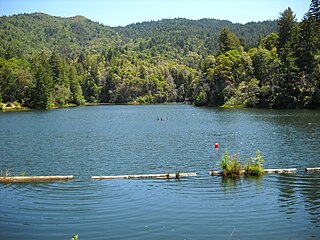| Twain Harte Dam | |
|---|---|
| Coordinates | 38°1′43.04″N120°14′37.44″W / 38.0286222°N 120.2437333°W |
| Opening date | 1928 |
Twain Harte Dam (National ID # CA00649) is a multiple arch dam in Tuolumne County, California. Its reservoir is Twain Harte Lake and it is located near Twain Harte, California.

An arch dam is a concrete dam that is curved upstream in plan. The arch dam is designed so that the force of the water against it, known as hydrostatic pressure, presses against the arch, compressing and strengthening the structure as it pushes into its foundation or abutments. An arch dam is most suitable for narrow canyons or gorges with steep walls of stable rock to support the structure and stresses. Since they are thinner than any other dam type, they require much less construction material, making them economical and practical in remote areas.

Tuolumne County, officially the County of Tuolumne, is a county in the U.S. state of California. As of the 2010 census, the population was 54,179. The county seat and only incorporated city is Sonora.

Twain Harte is a census-designated place (CDP) in Tuolumne County, California, United States. The population was 2,226 at the 2010 census, down from 2,586 at the 2000 census. Its name is derived from the last names of two famous authors who lived in California, Mark Twain and Bret Harte.
Developers began building Twain Harte Dam in the summer of 1927. [1] It was completed in 1928 and is owned by the Twain Harte Lake Association. [2] The dam is 36 feet (11 m) high, 325 feet (99 m) in length, and 8 feet (2.4 m) in width. [3] The dam has a crest elevation of 3,509.8 feet (1,069.8 m) and its volume is 1,197 cubic yards (915 m3).
In August 2014, fracturing of a granite dome known as "the Rock" located adjacent to the dam forced the closing and draining of the lake for safety reasons. [4] [5] It was feared the dam would fail and there would be a flash flood in Sullivan Creek. [6] The cause of this fracturing is a process known as exfoliation . [7]

Granite domes are domical hills composed of granite with bare rock exposed over most of the surface. Generally, domical features such as these are known as bornhardts. Bornhardts can form in any type of plutonic rock but are typically composed of granite and granitic gneiss. As granitic plutons cool kilometers below the earth’s surface, minerals in the rock crystallize under uniform confining pressure. Erosion brings the rock closer to earth’s surface and the pressure from above the rock decreases; as a result the rock fractures. These fractures are known as exfoliation joints, or sheet fractures, and form in onionlike patterns that are parallel to the land surface. These sheets of rock peel off the exposed surface and in certain conditions develop domical structures. Additional theories on the origin of granite domes involve scarp-retreat and tectonic uplift.

Exfoliation joints or sheet joints are surface-parallel fracture systems in rock, and often leading to erosion of concentric slabs. (See Joint.
Twain Harte Lake is the name of the reservoir created by Twain Harte Dam. It has a normal water surface of 12 acres (4.9 ha), and a maximum capacity of 143 acre feet (176,000 m3). Its drainage area is 1.04 square miles (2.7 km2). The lake is used for recreation and is available only to members of the Twain Harte Lake Association.

A drainage basin is any area of land where precipitation collects and drains off into a common outlet, such as into a river, bay, or other body of water. The drainage basin includes all the surface water from rain runoff, snowmelt, and nearby streams that run downslope towards the shared outlet, as well as the groundwater underneath the earth's surface. Drainage basins connect into other drainage basins at lower elevations in a hierarchical pattern, with smaller sub-drainage basins, which in turn drain into another common outlet.













